The Ultimate Guide to Airbnb Pricing Strategies
.webp?u=https%3A%2F%2Fimages.ctfassets.net%2Fpqmtoyw9z10u%2FGfiOYHlqwWz7zuhb3UFlH%2Fe72d038662e90e620922321df9f8310d%2Fclay-banks-zGRQYKuNa2E-unsplash__1_.webp&a=w%3D960%26h%3D640%26fm%3Dwebp%26q%3D75&cd=2025-06-27T11%3A51%3A34.974Z)
Mastering Airbnb pricing strategies is more than just setting a nightly rate. It's a dynamic exercise that involves understanding the nuances of pricing, guest behavior and overall travel and economic trends.
With more competition than ever and travelers looking for discounts, implementing the right pricing strategies can dramatically influence your bookings, occupancy rates and overall revenue, and is one of the most important aspects of running a successful vacation rental business.
In this article, we’ll dive deeper into proven methods that will help you unlock your Airbnb property’s potential and optimize revenue all year round.
Why Airbnb Pricing Strategies Matter
Pricing is not just about numbers. It’s about attracting guests, maximizing your revenue and maintaining a sustainable operation in the short-term rental market. The right Airbnb pricing strategies are essential for several reasons:
Boost occupancy: Consistent, strategic pricing helps fill your calendar, even during quiet periods or low seasons.
Stay competitive: By keeping your rates in line with demand, competitor rates and local events, you make sure your vacation rental property is top of mind for potential guests.
Optimize revenue: Dynamic, data-driven pricing strategies let you capture the highest possible revenue in both high and low seasons.
Adapt to market shifts: Travel trends, guest preferences and short-term rental regulations are always changing — your pricing model needs to keep pace.
Key Factors Influencing Airbnb Pricing
Before choosing or refining your Airbnb pricing strategies, let’s break down the key factors that influence what you can charge and when:
Market demand: Are you in a tourist hotspot with year-round demand, or a city with strong seasonal demand?
Local events: Festivals, conferences and concerts can cause demand — and nightly rate — to skyrocket.
Competitor rates: Monitoring similar listings in your area and similar areas helps ensure you set the right price to stay competitive.
Property type: Is your home a luxury penthouse, family condo or cozy cabin? The type of your property and the guests it attracts affects your price ceiling.
Location: Proximity to attractions, experiences, restaurants and transportation all matter.
Guest experience and reviews: Positive guest feedback can justify premium pricing while negative ones may require lower rates until your reputation recovers.
Operational costs: Don’t forget cleaning fees, cleaning service costs, utilities and additional services. These must be factored into your base rate and overall rate.
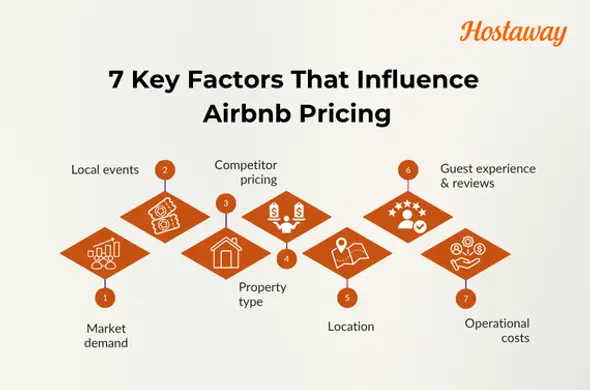
How to Set the Base Rate for Your Airbnb Vacation Rental
Your base rate is the starting point for all your pricing strategies. It’s what you’d charge on an average night with no special circumstances. Dynamic pricing tools generally use the base price as a benchmark to make pricing changes.
How to calculate your base price
Analyze competitor pricing: Search for similar listings in your area. What is the average rate for properties like yours?
Factor in operational costs: Add up all expenses — utilities, cleaning and maintenance costs, taxes, property management fees, etc.
Adjust for your property’s unique features: A hot tub, renovated kitchen or amazing view can boost your base price.
Review historical data: Look at your previous years' performance to identify your sweet spot — the nightly rate that maximized both bookings and revenue.
Static vs. Dynamic Pricing Strategies
What is static pricing?
Historically, many Airbnb hosts set a single, fixed nightly rate and rarely changed it. While easy, this traditional method ignores demand for short-term rentals, the available supply of properties, seasonal effects and more, potentially costing property owners both bookings and revenue.
When might static pricing work?
Unique or ultra-high-demand properties with little competition
Extremely stable markets with little seasonal demand
Property owners who prefer simplicity and minimal adjustments over optimizing occupancy and profitability
What is dynamic pricing?
Successful Airbnb hosts and professional property management companies use dynamic pricing. This approach adjusts your nightly rate automatically — usually daily — in response to real-time factors such as:
Supply and demand
Local events
Special holidays
Competitor pricing
Day of the week (weekends vs. weekdays)
Lead time before check-in
High and low seasons
Dynamic pricing enables you to capture higher revenue during peak times while offering discounts or lower prices to boost occupancy during quiet periods, maintaining occupancy rates at an optimum level for your vacation rental business.
Smart Pricing vs. Dynamic Pricing Tools
What is Airbnb Smart Pricing?
Airbnb offers its own built-in smart pricing feature (Airbnb Smart Pricing), which automatically adjusts your pricing based on proprietary signals. While convenient, it often prioritizes maximizing bookings (and thus Airbnb’s own fee income) over your total revenue.
What are dynamic pricing tools?
Professional hosts and property management teams often turn to third-party dynamic pricing tools or revenue management software for deeper customization, better analytics and more control that lead to higher profitability and revenue across all your listings, not just Airbnb.
Essential Airbnb Pricing Strategies for Property Managers and Hosts
1. Ensure quality across the guest journey
Before any pricing tweaks, quality is foundational. It's what leads to positive reviews, and according to Airbnb, listings with an average of 80% five star reviews received 69% of total bookings last year.
"Investing in quality optimizes your earnings," says Julia Herrington, Senior Program Operations Manager at Airbnb. Cleanliness, listing accuracy, guest communication and smooth check-in are central to quality. Properties that excel here not only achieve higher occupancy but also have more flexibility in their pricing strategies, enabling higher average nightly rates and more favorable reviews.
2. Optimize availability and reduce booking friction
The more dates a listing is available, the more likely it will fit a guest’s plans.
Remove unnecessary booking restrictions , ensuring your property is visible for as many searches as possible. Flexible check-in options (like Instant Book and self check-in) further remove barriers to bookings and support increased occupancy.
3. Dynamic rules for gap nights
Don’t let your calendar develop small, unbooked “gap nights” or "sandwich nights."
Use Hostaway's dynamic rule feature to automatically enable reservations for gap nights between stays, which means you can fill otherwise empty slots and boost occupancy. This is a powerful way to keep your pricing strategies competitive and your revenue steady.
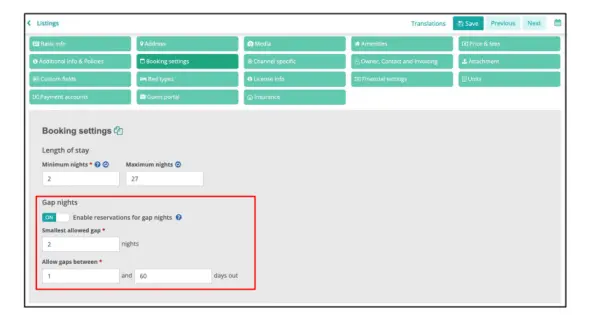
4. Leverage promotions and discounts strategically
The data is clear: Discounts work. According to Airbnb, active listings that decrease their price by at least 5% or more, generate, on average, 22% more nights booked over the next year compared to those that don’t.
Promotions such as new listing promotions, non-refundable cancellation options and early bird discounts all help you capture more bookings and improve your search ranking. And with Hostaway, you can easily push these offers across multiple listings.
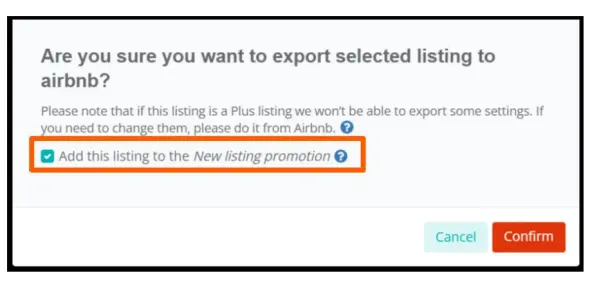
5. Flexible cancellation policies and non-refundable options
"Choosing a cancellation policy is really a balancing act. You want to avoid cancellations while still attracting guests, and today's guests want more flexibility as they plan their upcoming travels," says Julia.
Offering both flexible and non-refundable cancellation policies can increase your appeal to different traveler types. The non-refundable option, which is a discounted rate in exchange for a booking guarantee, protects you from last-minute cancellations and make your listing more attractive to budget-conscious travelers.
6. Keep Your price dynamic. Don’t set and forget
Static pricing is a missed opportunity.
Adjust your nightly rate and discounts regularly using real-time data, seasonality and local market conditions. Hostaway Dynamic Pricing is designed to make this process seamless, enabling you to implement rules across your portfolio and respond to fluctuations in market demand, special events and booking pace.
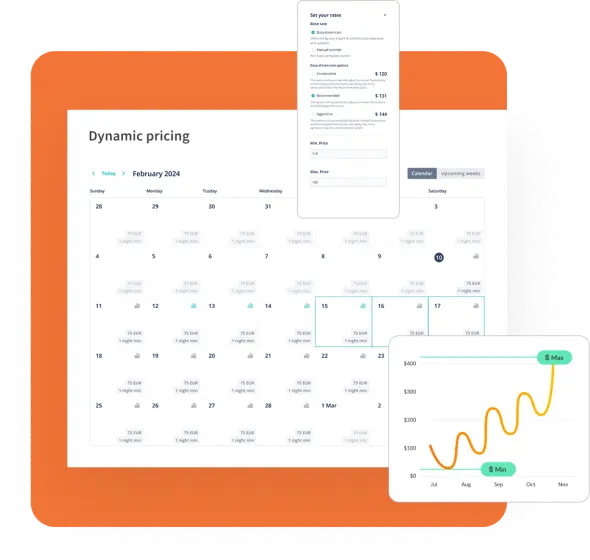
Advanced Airbnb Pricing Strategies: Data-Driven Pricing
Modern Airbnb pricing strategies are built on data and automation — not guesswork. The Hostaway Dynamic Pricing tool is designed for today’s professional hosts and property management teams, giving you a robust platform to optimize revenue, stay competitive, and keep occupancy high.
How Hostaway Dynamic Pricing works
Real-time data integration: Hostaway pulls in current market data—including competitor rates, seasonal trends and local events — and analyzes billions of data points so your listings are always positioned at the optimal price.
Automated pricing rules: Set your base price, then use Hostaway’s automated rules to adjust for lead time, day of week, gap nights and demand spikes, ensuring you never leave money on the table.
Customizable strategy across multiple listings: Manage all your properties from a single dashboard, applying different pricing strategies and promotions per property type or location.
Optimize for demand and events
Hostaway’s tool lets you automatically increase your nightly rate for local events or periods of high demand, and decrease for quiet periods or to fill last-minute gaps.
Leverage analytics for continuous improvement
Use Hostaway’s built-in analytics to track how pricing changes impact bookings, occupancy and overall revenue.
The Quality Dashboard and AI Insights help you connect pricing decisions with guest experience and reviews, revealing which changes drive better results.
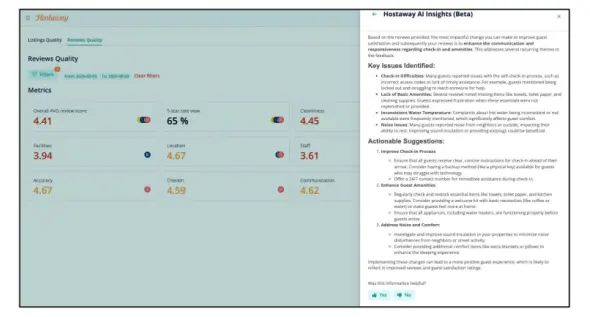
Guest Communication and Experience
Transparent, proactive guest communication around pricing, discounts and additional services can help set expectations and increase positive reviews. Always explain the value guests receive for the price: Location, amenities, support from your team or unique experiences.
Remember, your guest experience doesn’t start at check-in — it starts the moment potential guests see your listing and price. The clearer, more competitive and more value-driven your pricing appears, the more likely you’ll win bookings.
Handling Short-Term Rental Regulations and Compliance
Staying on top of local short-term rental regulations is an important aspect of pricing and running a legal, successful Airbnb. Some cities cap maximum nightly rates, mandate cleaning service standards or restrict discounts. Make sure your pricing strategies comply with all local rules to avoid fines or delisting.
Common Mistakes to Avoid When Setting Your Airbnb Pricing
Ignoring market data Set and forget is not a strategy. Always use up-to-date data for your pricing decisions.
Not updating for local events or seasonal changes Failing to raise your nightly rate during a festival or high season is a missed opportunity.
Overcharging or undercharging Both can hurt your bookings and revenue. Find the right balance.
Neglecting operational costs Ensure your base price and cleaning fees cover all expenses so you’re not losing money on every stay.
One-size-fits-all for multiple listings Each property is unique; tailor your pricing strategies accordingly.
Measuring Success and Iterating Your Pricing Strategy
Key steps to continuous improvement:
Track your bookings, occupancy and revenue each month.
Compare your results to the past year and local averages.
Solicit and review guest reviews for pricing feedback.
Adjust your pricing model, base price and discounts as needed.
Leverage your support team or property management company for fresh insights.
Master Airbnb Pricing to Stay Ahead
Airbnb pricing strategies are the backbone of successful property management and a thriving Airbnb business. With more data, technology and tools than ever, hosts can unlock their property’s potential, optimize revenue and stay ahead of the competition.
Remember: Pricing is never “set it and forget it.” It’s a living process — test, measure, adjust and always put yourself in the shoes of your target audience. Whether you’re managing one listing or a portfolio of multiple listings, the right price will help you achieve more bookings, better occupancy rates and sustainable, long-term success.
Ready to find out how Hostaway can transform your business?
